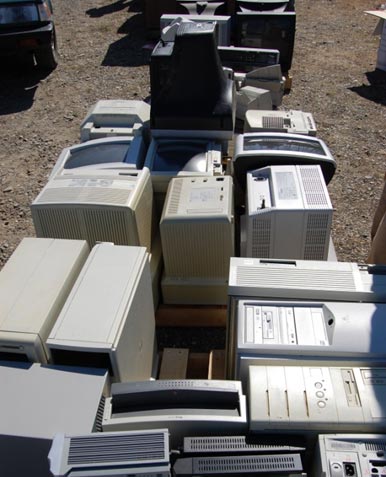
2/15/19 Beyond Data Privacy Risks – the Growing e-Waste Problem
Before you allow your IT staff to toss out or start dismantling unwanted, broken and obsolete electronic equipment, also known as e-waste, please be aware of the health and environmental risks associated with certain internal components.
Now your staff might think, “There’s no way our telecom equipment, cell phones and computers are dangerously toxic. If they were, they wouldn’t be allowed in the office or we’d all be sick.” They’re half right.
The sleek and stylish finished electronic product is safe. It’s the disassembled parts that can expose employees and environments to toxic elements such as arsenic, barium, beryllium, cadmium, chromium, lead, lithium, mercury, and flame retardants. Materials you do not want wafting into the company cafeteria air or migrating into human bodies, drinking reservoirs or agricultural soils. Exposure to e-waste chemicals can cause damage to the nervous system, brain, heart and kidneys to name a few. Yikes!
Make no mistake—E-waste is a growing worldwide pollution problem as electronic product life cycles get shorter and shorter due to client demands for the latest and greatest. Further complicating the problem, some of the e-waste is getting recycled into black plastic, which has limited uses, retains some toxicity and can’t be recycled effectively itself due to the molecular structure.
In its most recent report, the United Nations Environmental Management Group predicted that 50 million metric tons of E-waste would be produced in 2018. This is a 19% increase from 2014 with no decrease in sight. The top ten e-waste producers per capita are Norway, Switzerland, Iceland, Denmark, United Kingdom, Netherlands, Sweden, France, United States and Austria.
Prior to the 1970s, companies around the world dumped chemicals into rivers or buried them in the soil not understanding the toxic impact to people and the environment. To avoid pollution history repeating itself, businesses are increasingly adopting green policies that encourage them to properly dispose of electronic waste instead of shipping it to local landfills where they increasingly face steep fines or even faraway places that will still accept it, toxifying the local environment.
At this point you may be wondering, what’s a health conscious and environmentally concerned company supposed to do about its own generated e-waste?
Hire companies like Castaway that use R2:2013 certified outlets. These outlets are audited and certified by third parties to responsibly recycle end-of-life electronics, equipment, components and materials.
While it might be tempting to drop old equipment off at the local church charity drive or the generic e-waste drop off in your building, please be aware that the haulers that pick up these materials may be non-certified outlets that utilize dubious export companies, mishandle toxic materials or contaminate landfills. Clearly, this is not the way environmental conscious companies dispose of e-waste.
The cost-effective and compliant solution
You can put your company’s minds at ease by using our clearly documented and certified I.T. asset disposition (ITAD) process. We’ll pack and remove your unwanted electronic equipment at a time convenient for you and follow all federal, state and local laws to ensure toxic materials get removed and disposed of properly.
Castaway will provide you with a detailed report of items received and recycled rather than a generic certificate of recycling or, worse, no certificate at all. That way your company remains e-waste compliant, keeping its employees and facilities safe and protecting the environment both near and far.
For more information about safe and law compliant e-waste disposal, data destruction, data center or other ITAD services, please contact us at (978) 208-4730 or contact us online.


